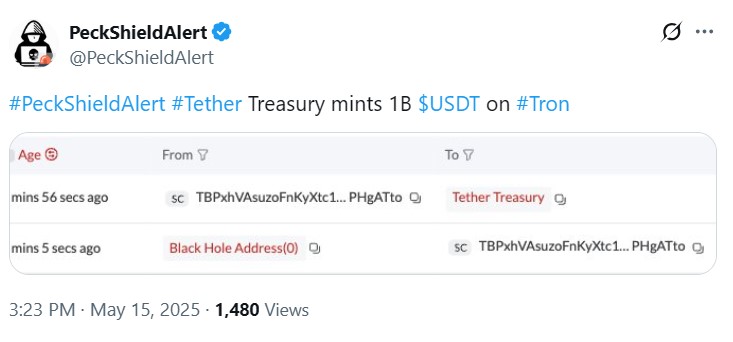Tether, the leading stablecoin issuer, has recently taken a significant step by minting an additional $1 billion USDt tokens on the Tron blockchain. This move has effectively pushed Tron’s authorized supply of USDT to a compelling $73.7 billion, placing it just ahead of Ethereum’s current total of $74.5 billion. Blockchain data reveals that as of May 14, these developments not only highlight Tron’s robust presence in the stablecoin market but also illustrate an ongoing battle for dominance between Tron and Ethereum.
The increase in Tether’s USDT minting reflects a strategic approach to liquidity management. CEO Paolo Ardoino noted that these mints are partly intended to replenish Tether’s inventory on various blockchains, ensuring there’s enough supply to meet the expected demand for future issuance and swaps. This inventory replenishment strategy is akin to how traditional businesses manage stock, which helps maintain operational efficiency.
“The authorized USDT supply on a network indicates the stablecoin issuer anticipates future issuance demand of the stablecoin on a blockchain,” Ardoino mentioned.
Moreover, data from CryptoQuant indicates that Tron led the circulation of USDT tokens from July 2022 to November 2024, before Ethereum temporarily took the lead with a notable $18 billion minting in 2025. However, Tron’s recent minting activities have propelled its supply back to the forefront, with $73.6 billion of USDT now circulating on its network compared to Ethereum’s $71.8 billion.
As the cryptocurrency sector continues to evolve, Tether’s strategic moves and Tron’s increasing supply reinforce the dynamic nature of stablecoins and their crucial role within the broader blockchain ecosystem.
Stablecoin Dynamics: Tether’s Impact on Blockchain Networks
Understanding Tether’s recent minting activities and the implications on stablecoin usage is critical for holders and potential investors in cryptocurrencies. Here are the key points regarding Tether’s minting of USDt tokens and its implications:
- Tether’s Recent Minting Activity:
- Tether minted an additional $1 billion USDt tokens on the Tron network.
- This minting increased Tron’s authorized USDT supply past that of Ethereum, which had $74.5 billion compared to Tron’s $73.7 billion.
- Tron’s circulating supply of USDT also leads at $73.6 billion, while Ethereum has $71.8 billion.
- Liquidity Management:
- Tether CEO mentioned that some minted USDT tokens are used for replenishing token inventory.
- This process helps ensure Tether can meet future issuance requests and maintain smooth liquidity management.
- Competitive Landscape:
- Ethereum and Tron continue to compete for USDT supply dominance, affecting their market positions.
- Solana and Avalanche are notable players, currently ranking third and fourth in authorized USDT supply.
- Tether’s total circulation reached a record $150 billion, giving it over 61% market share among USD stablecoins.
- Market Implications:
- Increased supply of USDT can influence prices and trading volumes across various cryptocurrency exchanges.
- The ongoing competition between networks could shape future investment strategies and risk assessments for investors.
- As Tether maintains a significant market share, users may prefer its stablecoin over competitors, which can affect overall market dynamics.
“The authorized USDT supply on a network indicates the stablecoin issuer anticipates future issuance demand.”
Tether’s USDT Mint: A Shift in Stablecoin Dynamics
The recent decision by Tether to mint an additional 1 billion USDt tokens on the Tron network has stirred up conversations about the competitive landscape of stablecoins. With this move, Tether’s authorized USDT supply on Tron now surpasses that of Ethereum, indicating a potential shift in market dynamics. This development highlights significant competitive advantages for Tether but also presents challenges for its competitors.
Competitive Advantages of Tether’s USDT Minting: One major advantage that Tether holds is its strategic positioning within the Tron network. With USDT’s circulating supply on Tron currently leading at $73.6 billion compared to Ethereum’s $71.8 billion, Tether demonstrates robust liquidity and installment capabilities that appeal to traders and investors alike. Additionally, Tether’s proactive inventory management through minting allows for immediate responses to market demands, playing a crucial role in maintaining their market dominance. This proactive approach not only solidifies Tether’s liquidity but also reassures users about the reliability of their stablecoin during volatile market conditions.
Competitive Disadvantages for Rivals: Meanwhile, challengers like Circle, with $60.4 billion in stablecoins, may find themselves at a disadvantage as Tether continues to capture market share. The substantial gap in liquidity could deter users from utilizing alternative stablecoins, thus hindering growth for emerging platforms. Moreover, Ethereum, traditionally seen as a leader in the decentralized finance space, could face reputational damage if it cannot maintain its standing against Tron in USDT supremacy.
Who Stands to Benefit and Who Faces Challenges? The direct beneficiaries of Tether’s minting strategy are traders and platforms that utilize USDT for transactions and liquidity management. With a significantly higher supply on Tron’s block, these users can expect faster transaction times and lower costs associated with token swaps. However, on the flip side, platforms that rely heavily on Ethereum’s ecosystem for stability may grapple with retention and user engagement as Tether’s shift potentially lures them towards Tron’s offerings.
In essence, Tether’s latest minting move not only solidifies its foothold in the stablecoin market but also poses strategic problems for competitors seeking to reclaim market share amidst evolving blockchain dynamics.

















